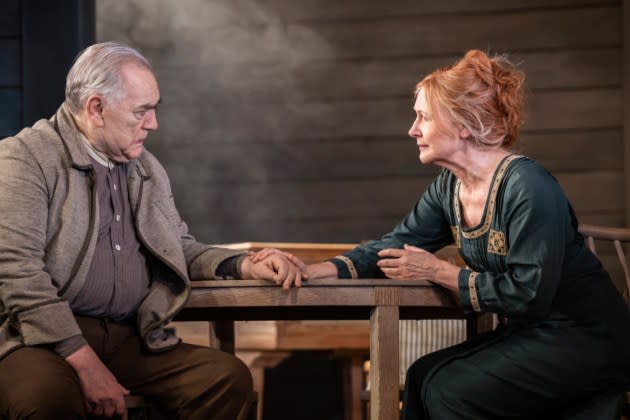‘Long Day’s Journey Into Night’ Review: Patricia Clarkson Illuminates an Uneven West End Production

No one, wisely, has turned “A Long Day’s Journey Into Night” into an opera — not least because, arguably, Eugene O’Neill’s most famous play already is one. It features extended solo arias mixing memory and pain, and, excluding the maid’s comedy high notes, the near-negligible plot operates as a vocal quartet. The job of the conductor — or, rather, the director — is to weave and build the sound to maximum dramatic effect. Led by Brian Cox (“Succession”) and Patricia Clarkson, Jeremy Herrin’s West End cast of soloists is definitely strong. Overall, however, his production doesn’t fully sustain the tricky balancing act.
The play, theater’s most potent study of denial, is harnessed by the dominant role of the overbearing father, James Tyrone, whose presence within the wretched, wrecked household requires him to loom large even when offstage. It’s a role that doesn’t just need threat; it requires an actor able to access fires within to fuel his rage.
More from Variety
The Roy Family Gets the Funko Pop Treatment in This New 'Succession' Vinyl Figure Collection
How Juliana Canfield Went From 'Succession' to Broadway's 'Stereophonic'
Brian Cox to Voice Santa Claus in Netflix Animated Feature 'That Christmas'
Given the terrifying and delicious ease he deployed as vicious Logan Roy in “Succession,” Cox makes complete casting sense as tyrannical, self-serving James. At 77, he is a trifle old for the role, which latterly strains credulity when it comes to the physical relationship between him and his sons. But as his bravura final scene demonstrates, he is a commanding presence.
Descending, through drink and exhaustion, to the state that is the closest he ever gets to insight about his controlling, miserly failure with his family, Cox is in fine form in this scene. Furious at the truth-telling of his combative younger son Edmund (Laurie Kynaston) he allows us to see a man just about able — for brief moments only — to glimpse the truth of his own responsibility in the terrible family psychodrama.
But the slow-burn arc of the role isn’t quite within his grasp. His opening scene is pitched too high: The family is self-consciously acting happy now that matriarch Mary (Patricia Clarkson) is home and sober, but Cox’s overly-signaled brightness militates against audience engagement.
That initial self-awareness also infects the two sons. Daryl McCormack has a fine, dismissive swagger as self-loathing James Jr., but the longer the play goes on — and in O’Neill’s overly insistent writing, it certainly is long — his lack of convincing connection to his sickly brother grows increasingly problematic. Yes, the boys are, for reasons finally uncovered, distant from one another. But for the family dynamic to work we need to see them not only fighting against that, but sharing a degree of closeness. Physical chemistry, here, is lacking.
The consumption killing Kynaston’s nicely considered Edmund is, mercifully, underplayed. He gently indicates sadness without overstating it and in the final showdown with his father, his self-possession works in balance to his father’s chaos. But elsewhere, like most of the characters in this production except Louisa Harland’s beautifully judged, knowing maid, he seems too isolated, as if playing the end of the play from the beginning.
Neurasthenic, fluttering and fragile, Clarkson’s Mary positively glides through the day of the play with a sweetness that beautifully belies her pain within. Her level of denial is so absolute that she is able to maintain dignity throughout, no matter how upsettingly empty her illusions are.
Herrin knows about secrets and lies in dramas of addiction, having directed Duncan MacMillan’s scorching, award-winning “People, Places, Things.” Here, his pacing of Clarkson’s performance is the strongest line through this production. His handling of her final moments, ultimately placing her calmly sitting on the edge of the stage, is masterly.
Elsewhere, not all of his choices are helpful to so drawn-out a text. Lizzie Clachan’s self-consciously bald, wooden set over-emphasizes the lack of money that James gives to the running of a household. More of a statement than a helpful design, it leaves the creation of atmosphere to the actors and the lighting. Even a lighting designer as skilled as Jack Knowles struggles with the demand.
In a play that goes to some length to point out the intrusive sound of fog horns, it seems antithetical to have so noticeable an additional soundscape that loudly alerts the audience to approaching doom, or to the ethereal quality of Mary’s blissed-out-on-morphine state. This soundscape fires up some moments but flattens out the following scenes. The irony of this is that in so notoriously wordy a play, it’s absence and, crucially, silence which have proved so lethal in their lives.
The cumulative power of a still horribly recognizable journey through desperate, misplaced hope has ensured the longevity of O’Neill’s drama. Despite the unevenness of this production, Clarkson’s tender glow keeps it alive.
Best of Variety
Sign up for Variety’s Newsletter. For the latest news, follow us on Facebook, Twitter, and Instagram.
